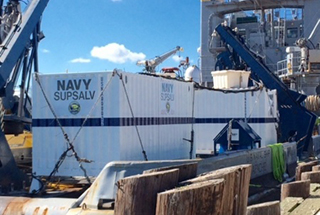A Navy deep salvage team and contractors began Saturday to comb the 100-square-mile area off the Bahamas where the 790’x95’ El Faro ro/ro container ship is believed to have gone down with its crew of 33 on Oct. 1 during Hurricane Joaquin.
The National Transportation Safety Board has said they anticipate the operation will take two weeks – about the expected lifetime of battery power on the El Faro’s voyage data recorder. The device can generate an acoustic homing signal for approximately 30 days after sinking, according to NTSB and Navy officials. The 226’x42’x15’, 7,200-hp Apache, a Powhatan-class fleet tug, left the Navy’s Little Creek amphibious base near Norfolk, Va., on Oct. 19.
The tug's crew includes contractors with Phoenix International Inc., Largo, Md., a company specializing in deep ocean operations including sonar searches and remotely operated vehicles (ROVs), who are operating a TPL 25 tow ping locator. Once the El Faro is located – either by the data recorder’s pinger signal, or the Apache’s side scan sonar – the plan is to send down an ROV to retrieve the recorder, NTSB officials have said.
Ship owners TOTE Maritime were poised to replace the El Faro in weeks with a new, liquefied natural gas-fueled vessel on the company’s regular runs between Jacksonville, Fla., and San Juan, Puerto Rico. The El Faro was then to go to TOTE’s Pacific Northwest base at Tacoma, Wash., freeing the company’s 839’x118’ trailership Midnight Sun for a 90-day project to convert it to dual fuel.
The work by Singapore-based Keppel Offshore & Marine Ltd. was to have begun in early November. But LNG World Shipping reported the sinking pushes TOTE’s timetable back a year for both the Midnight Sun and Orca-class sister ship North Star, which had been scheduled for LNG conversion in winter 2016-2017.
TOTE and its corporate parent, Saltchuk, have made major commitments to LNG, and how that goes forward could affect wider adoption of gas fueling for marine transport in the Pacific Northwest. Puget Sound Energy in January signed a deal with TOTE to supply gas for the ships, and there are plans for a LNG liquefaction terminal at the Port of Tacoma by the end of 2018.
Meanwhile, NTSB investigators continue digging into the history of the El Faro. In an Oct. 20 update, the agency said Capt. Michael Davidson on the morning of Oct. 1 had “reported that there was a hull breach, a scuttle had blown open, and that there was water in hold number 3. He also said that the ship had lost its main propulsion unit and the engineers could not get it going.”
Earlier in the year Coast Guard inspectors and American Bureau of Shipping surveyors had approved the ship’s condition, including its main propulsion, auxiliary and emergency systems, the NTSB said.
“On September 11, 2015, TOTE received permission from the Coast Guard to shut down one of the ship’s two boilers so it could be inspected by an independent boiler service company during a voyage between San Juan and Jacksonville,” according to the NTSB. “As a result of the inspection, the boiler service company recommended service to both boilers during an upcoming dry-docks period that had already been scheduled for November 6, 2015. The boiler was returned to service following the inspection.”
As the NTSB investigators work and the Navy trolls 15,000’ depths off the Bahamas, lawyers for families of lost crewmen are at work too. So far three lawsuits are reported to be filed against TOTE, alleging material deficiencies in the El Faro and faulting the captain’s decisions.




